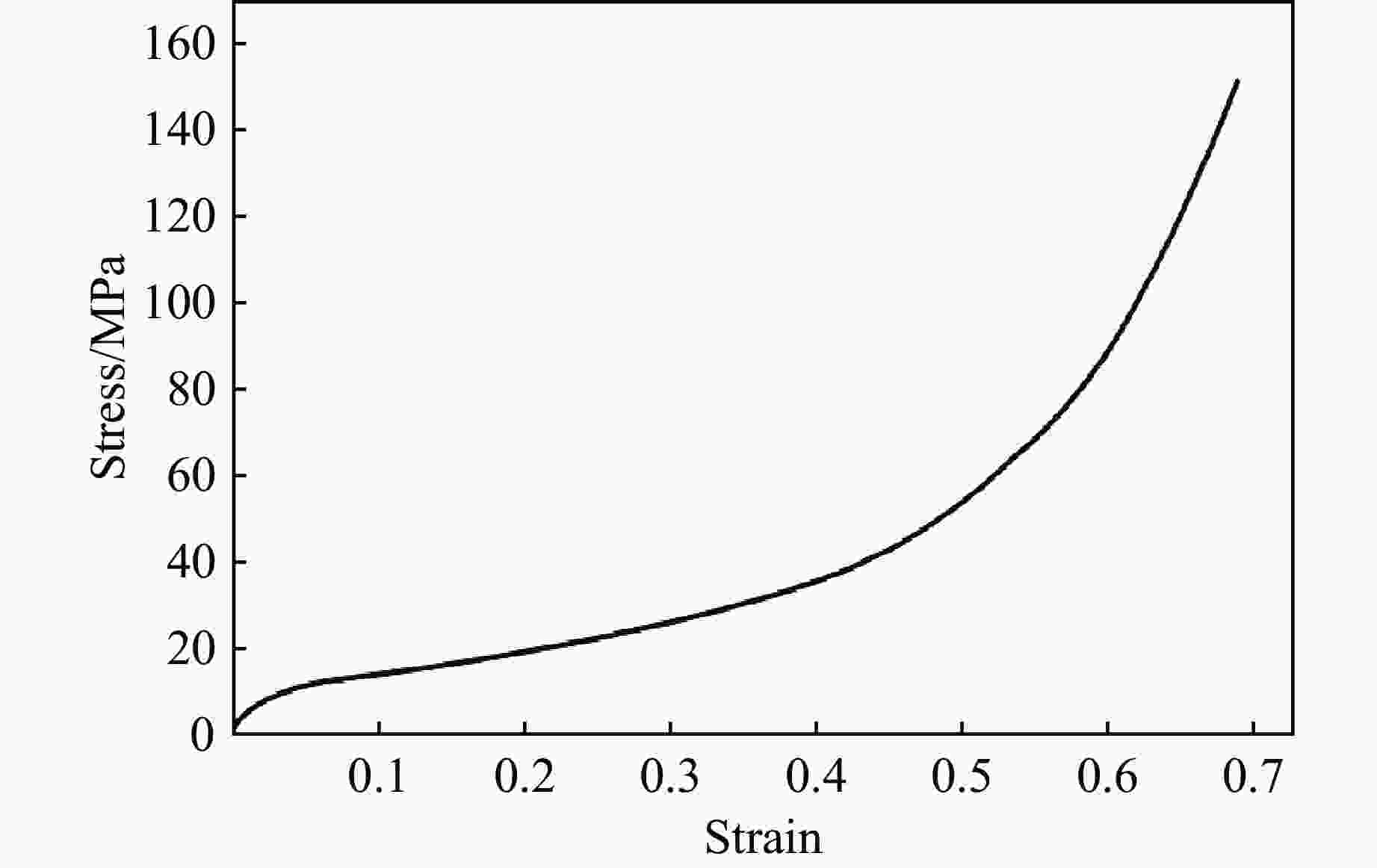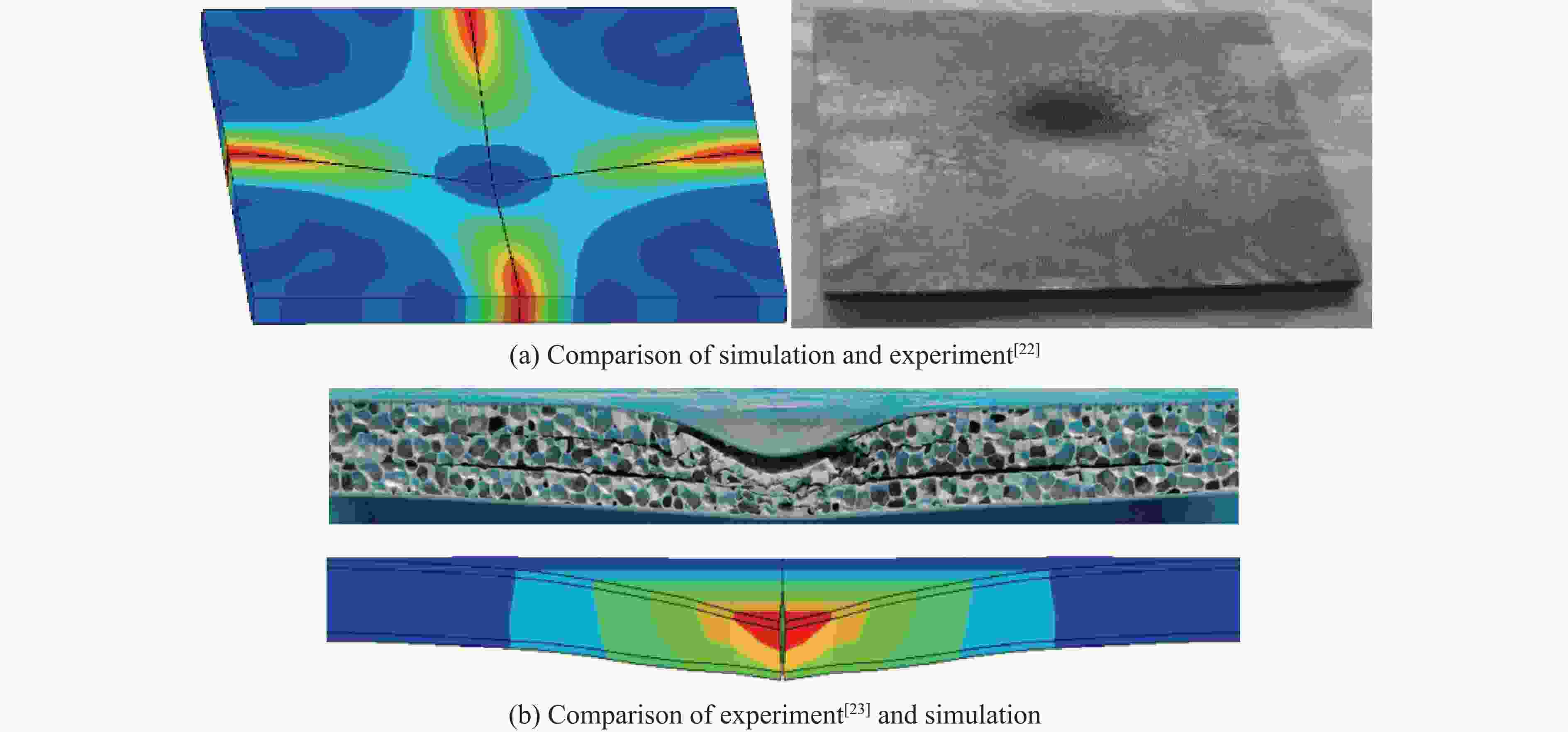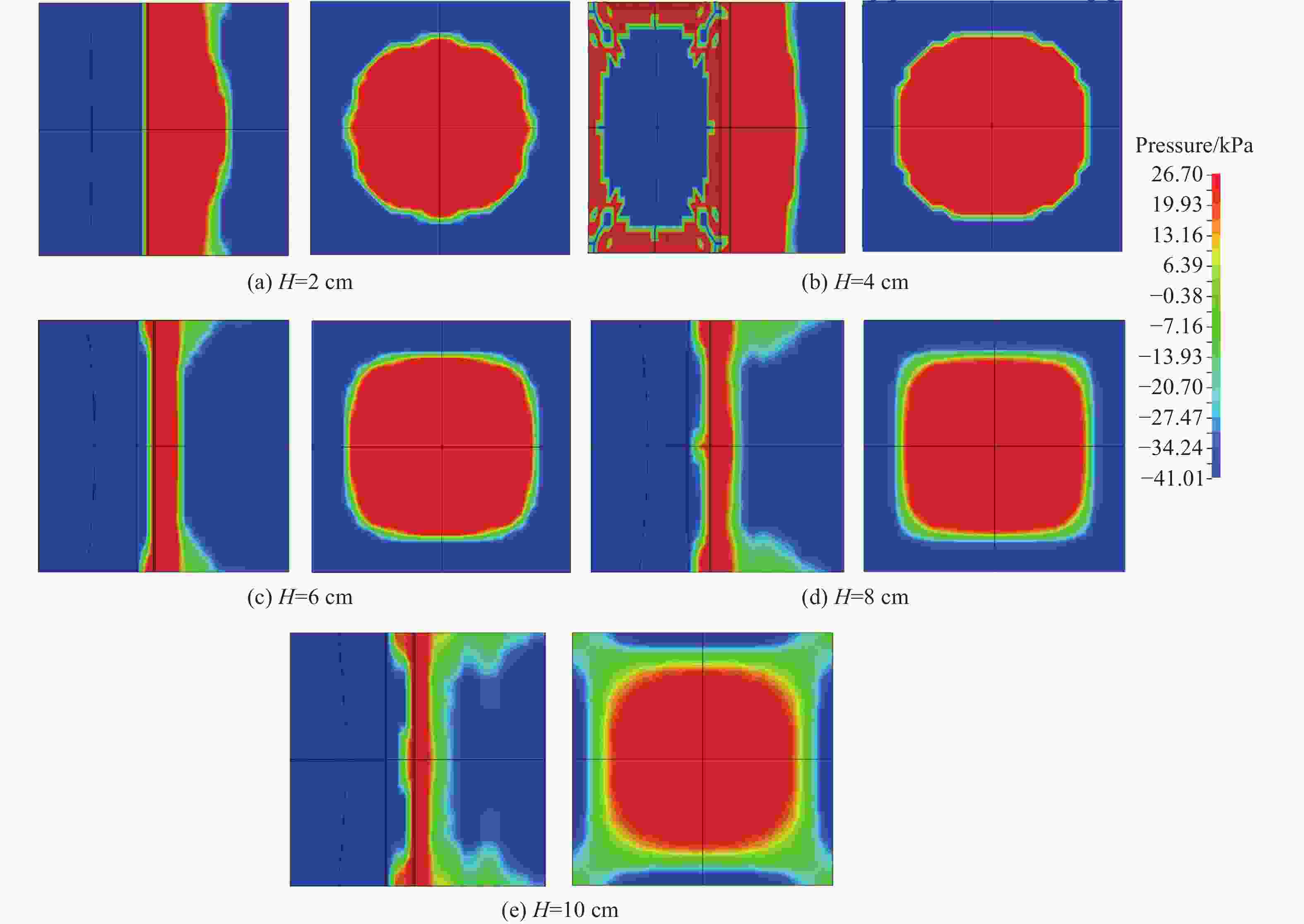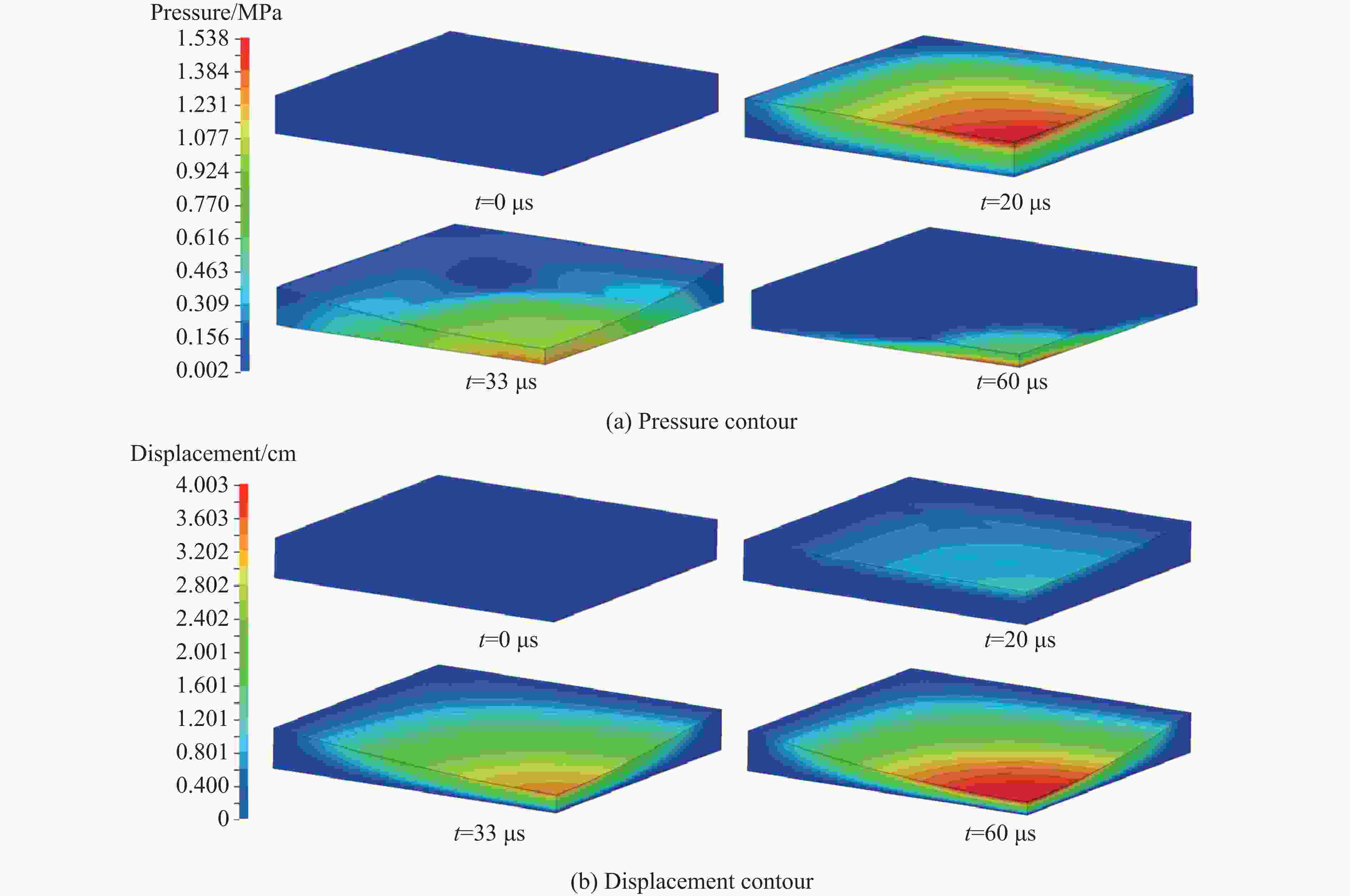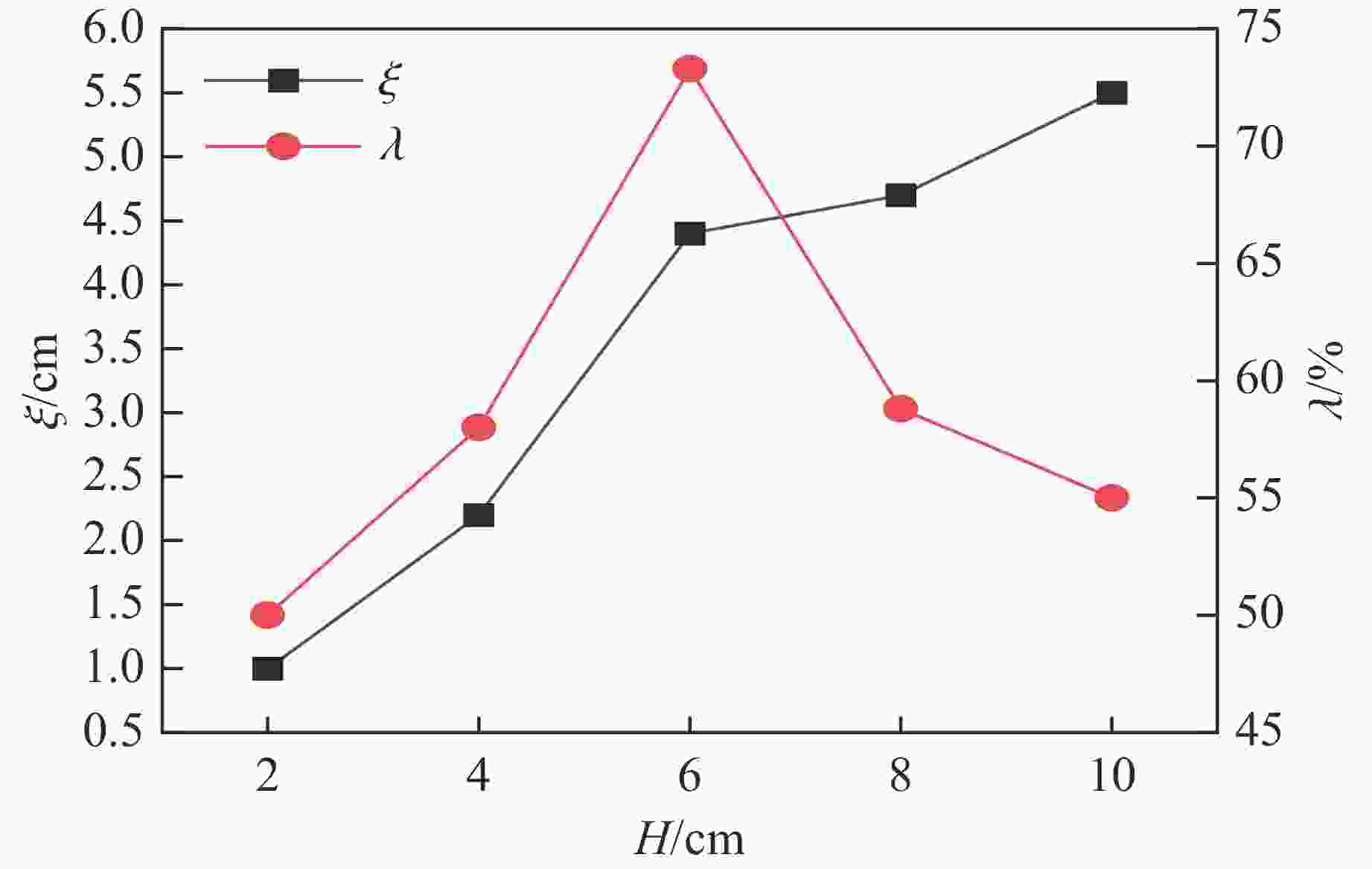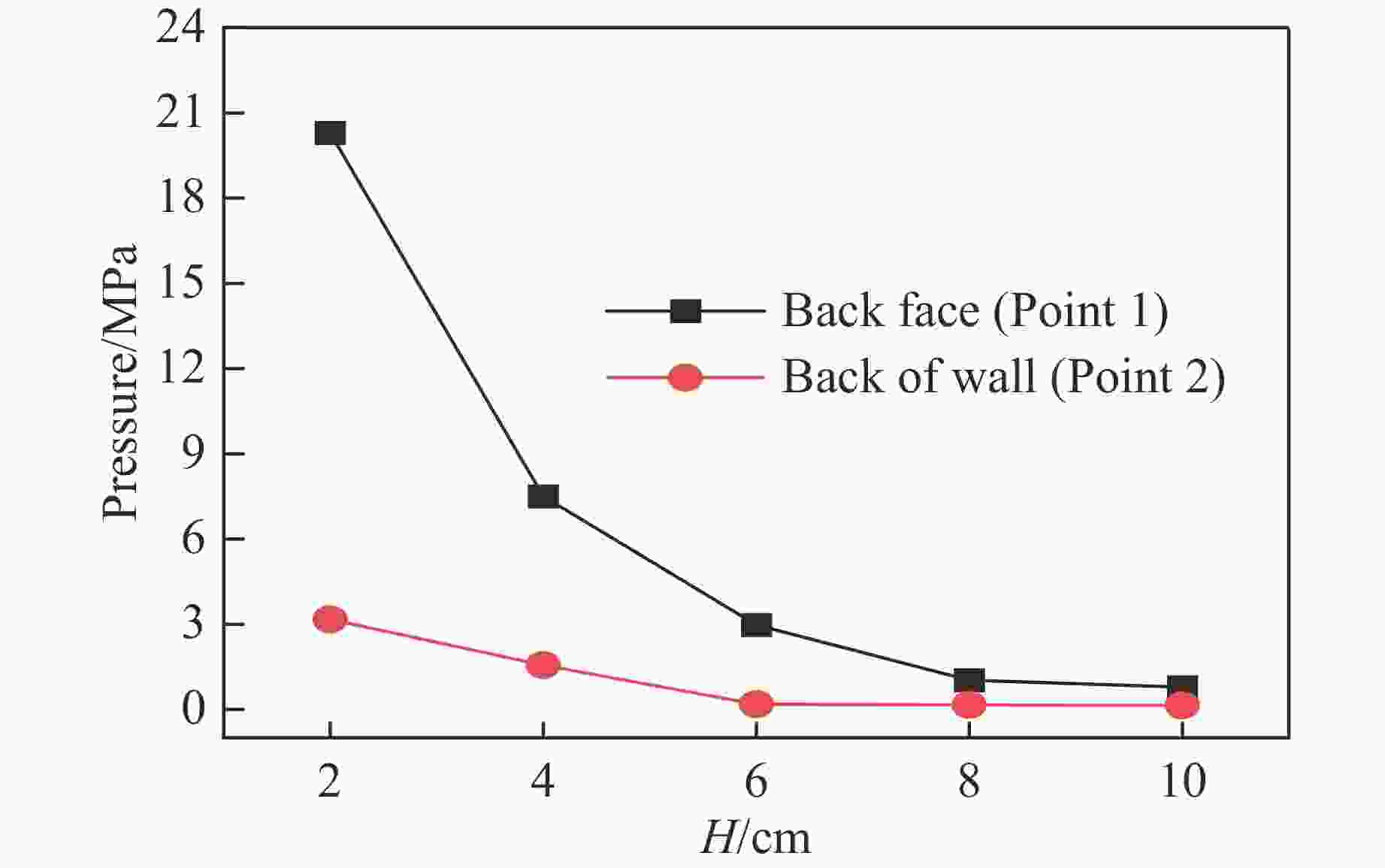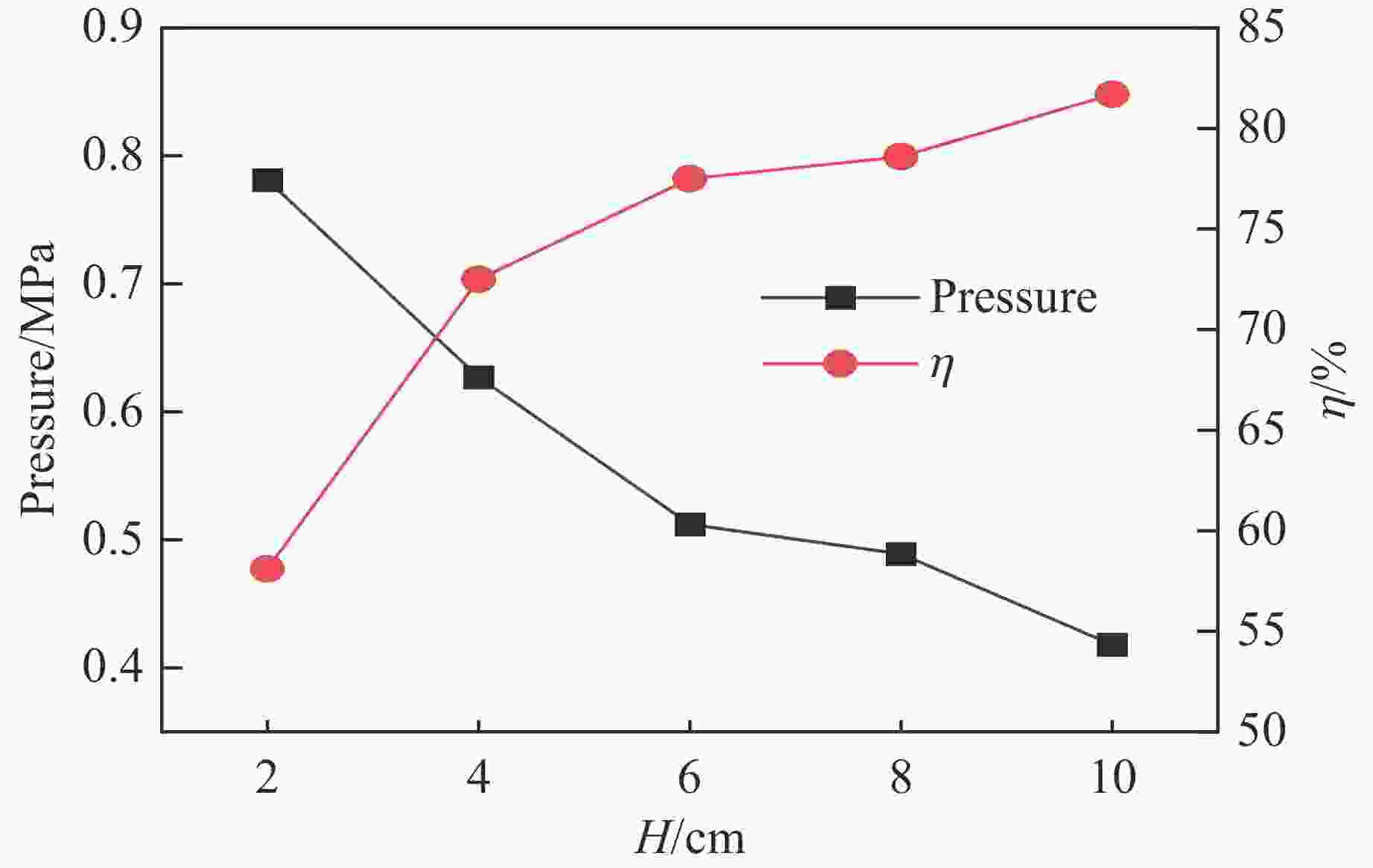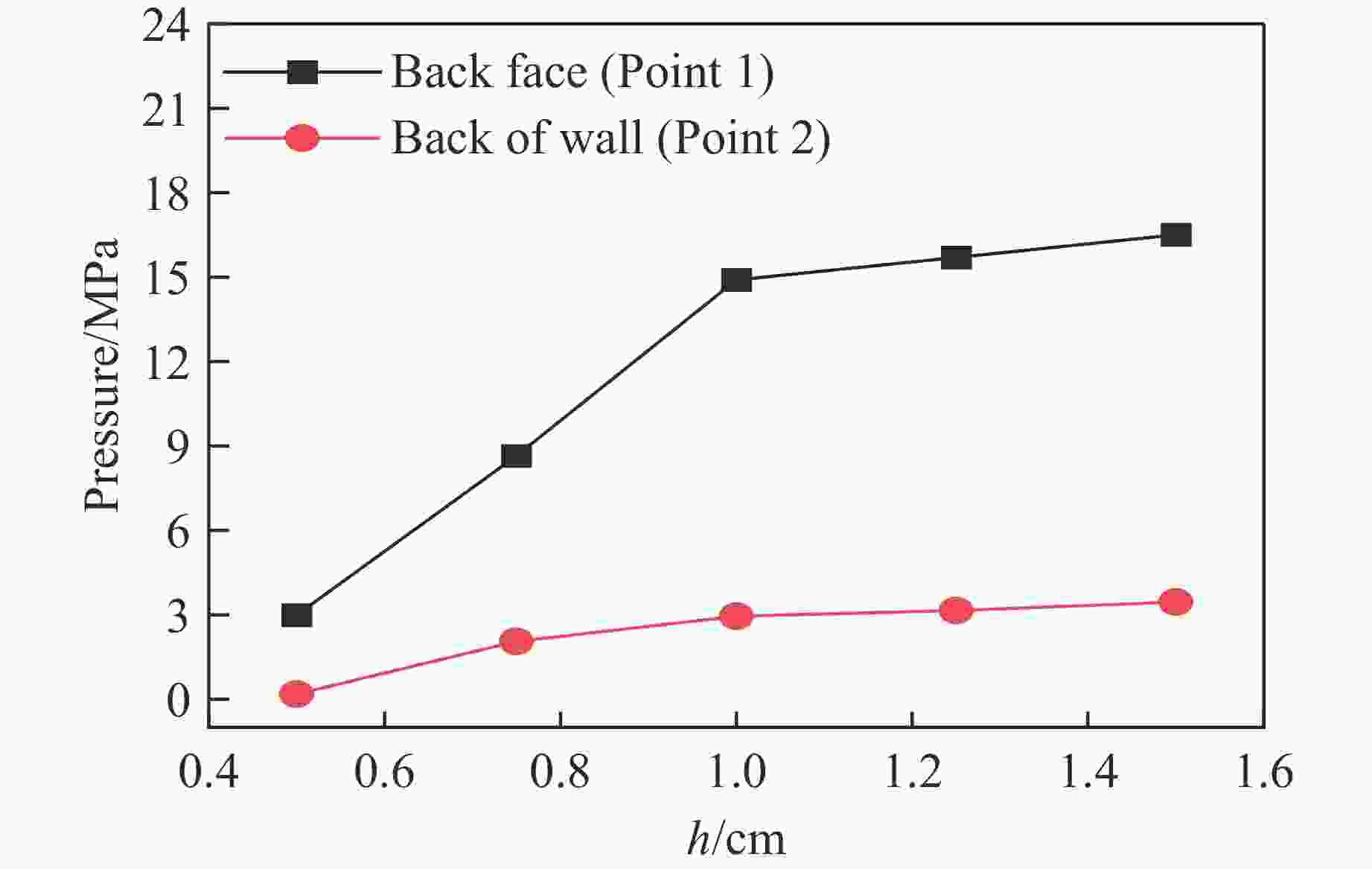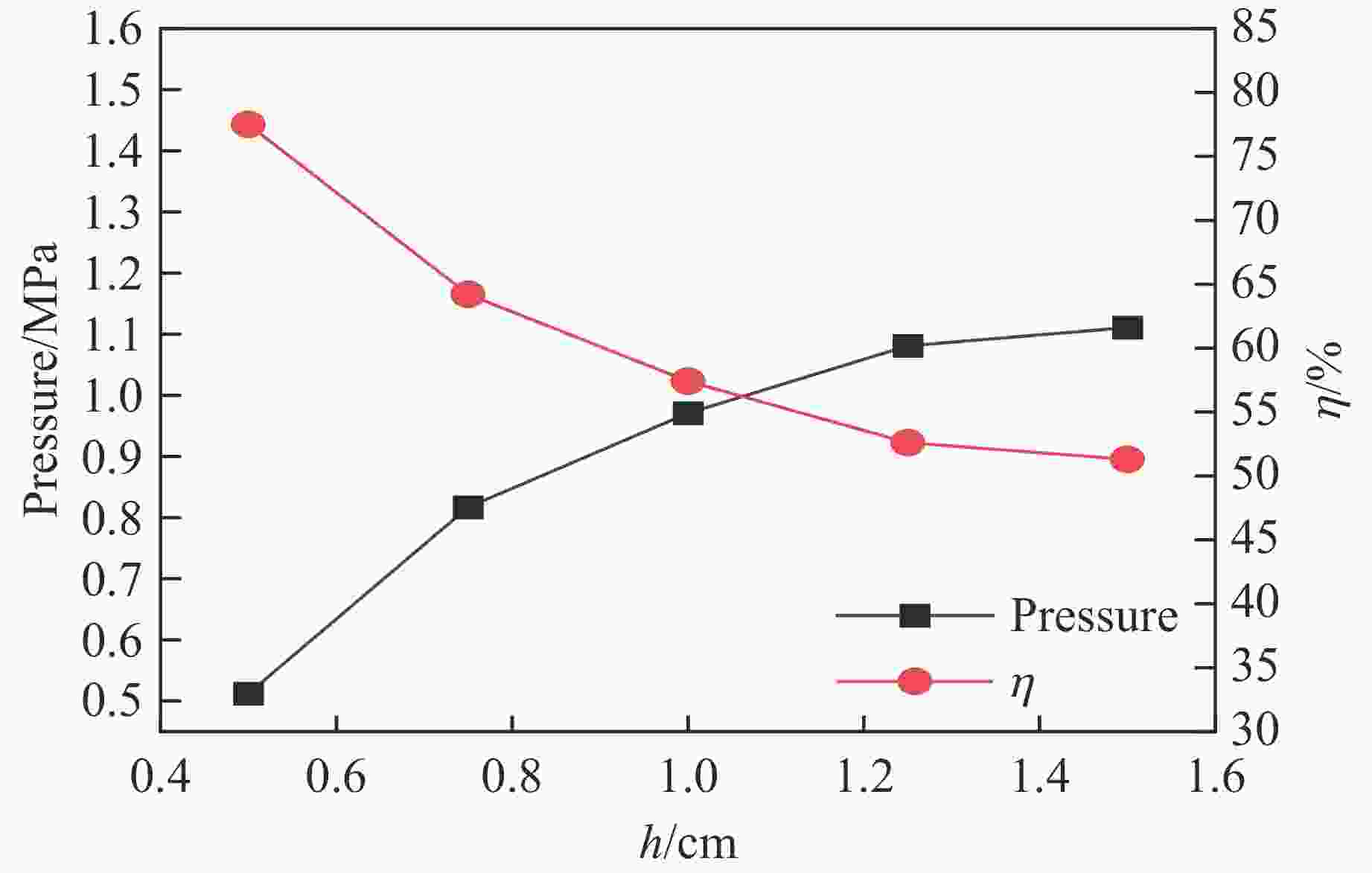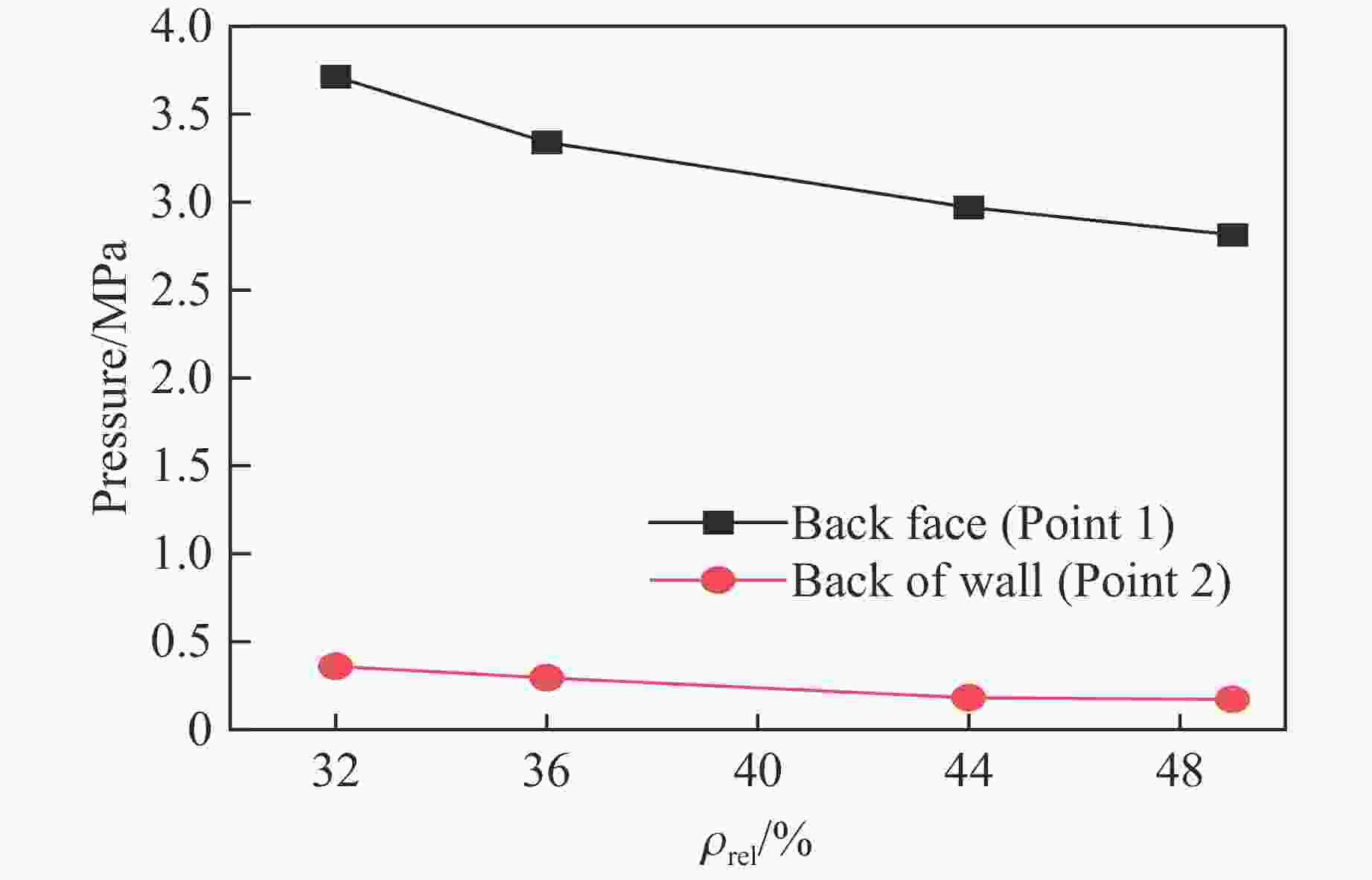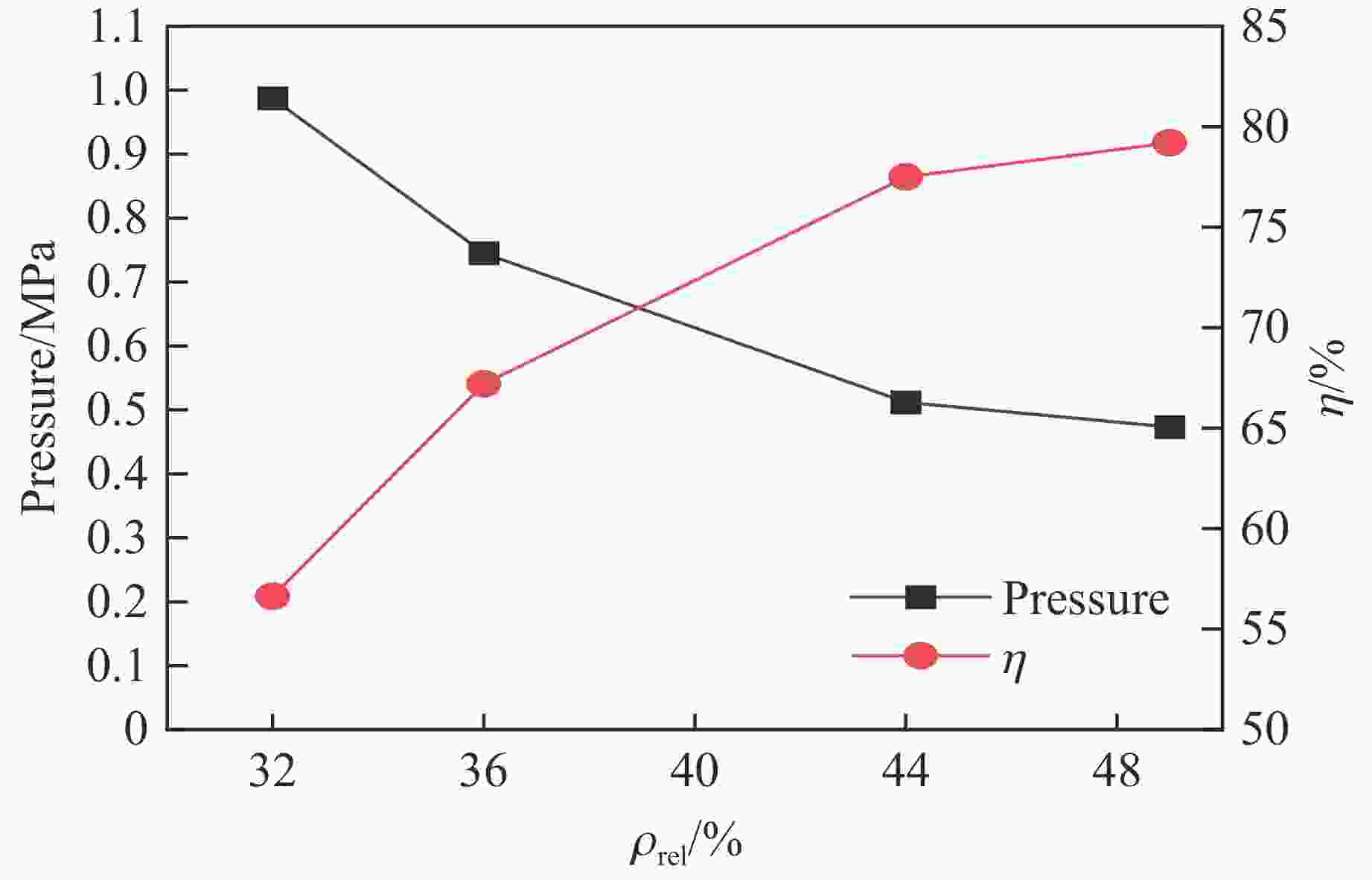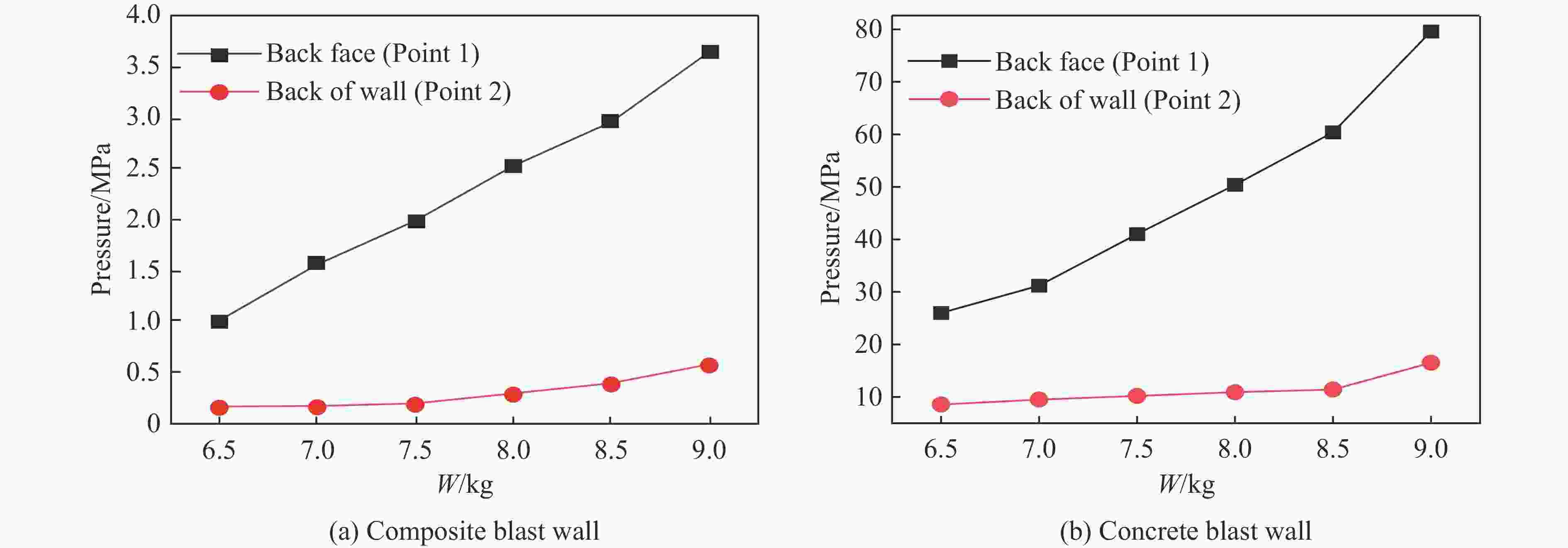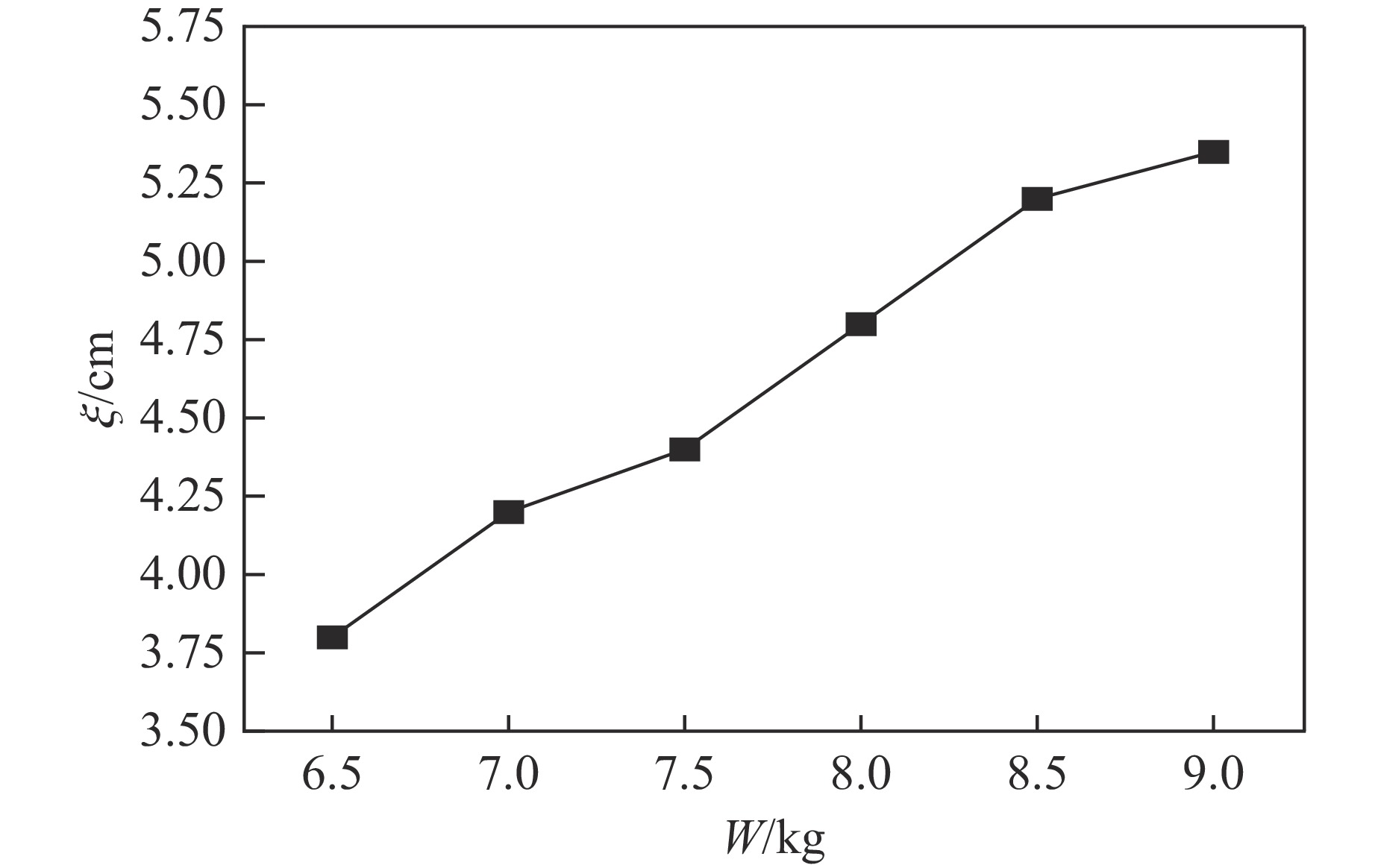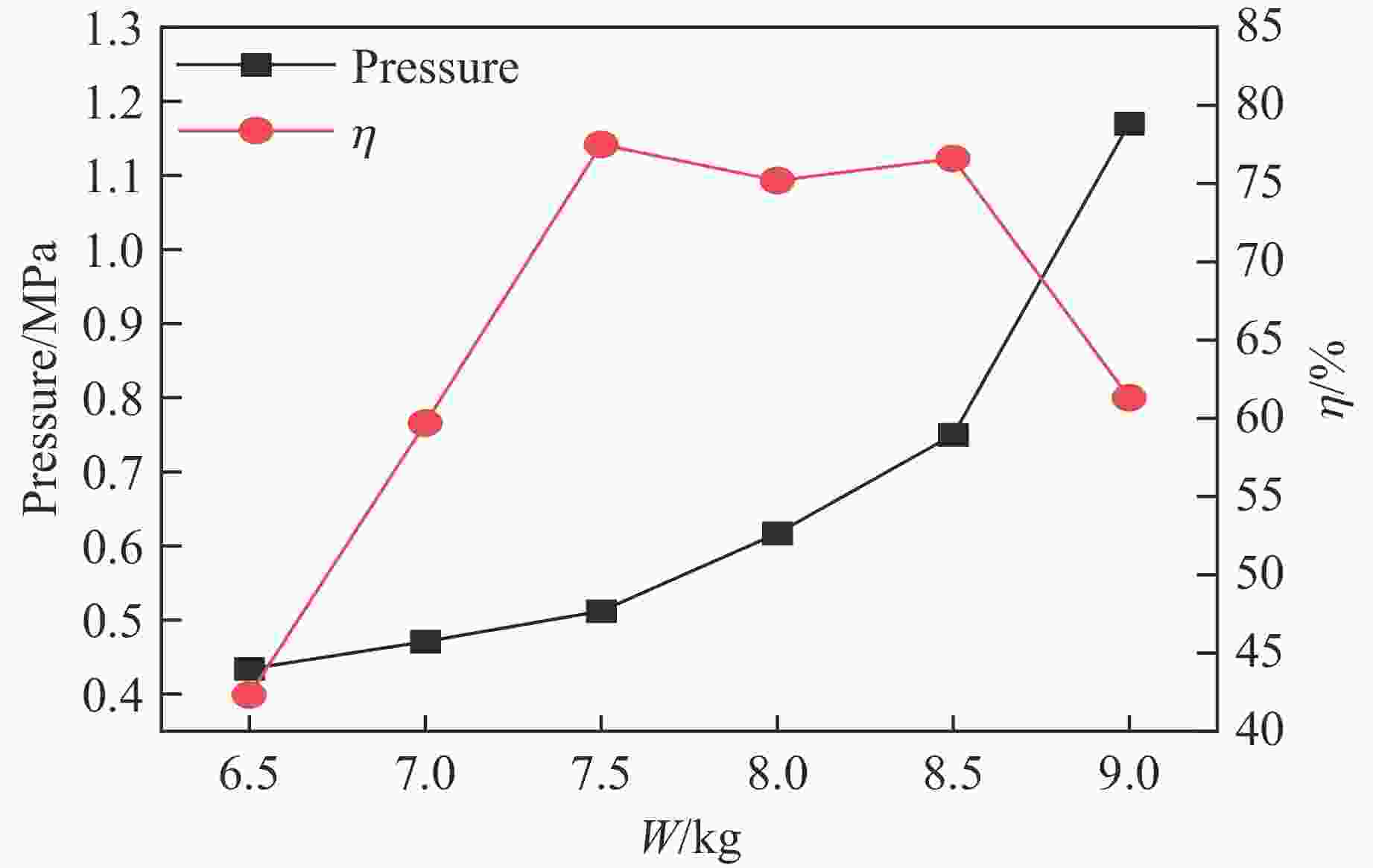Anti-Explosion Performance of Composite Blast-Resistant Walls Containing an Aluminum Foam Energy-Absorbing Layer
-
摘要: 为研究泡沫铝吸能层对混凝土防爆墙抗爆性能的影响,采用LS-DYNA有限元软件模拟含泡沫铝吸能层复合防爆墙的抗爆动态响应,分析泡沫铝夹芯板结构参数、泡沫铝相对密度、爆炸载荷强度对其压缩变形规律和抗爆性能的影响。结果表明:在承受爆炸载荷作用时,复合防爆墙主要通过前面板局部弯曲变形和芯层塑性压溃变形吸收爆轰波能量;复合防爆墙的抗爆性能与芯层厚度呈正相关,与面板厚度呈负相关,但面板过薄时会因强度不足出现局部破裂失效;随着泡沫铝相对密度的增大,防爆墙的抗爆性能先显著提升后趋于平缓,当相对密度超过临界阈值后,材料波阻抗梯度降低,致使其防护效能显著削弱;7.5 kg装药、爆距为50 cm的爆炸加载条件下,芯层厚度6 cm、面板厚度0.5 cm、泡沫铝相对密度44%时能充分发挥材料的吸能特性,此时芯层的压缩比为73.3%,复合防爆墙的削波系数为77.5%;随着爆炸载荷增加,复合防爆墙的削波系数呈现“强化-平衡-失稳”的变化趋势。研究结果可为泡沫铝在抗爆防护中的应用提供参考。Abstract: To investigate the effect of the aluminum foam energy-absorbing layer on the blast-resistance performance of concrete blast walls, LS-DYNA was used to simulate the dynamic response of composite explosion-proof walls with aluminum foam energy-absorbing layers. The study analyzed the influences of the structural parameters of the aluminum foam sandwich panel, the relative density of the aluminum foam, and the intensity of the explosive load on the deformation patterns and the blast-resistance performance. The results show that during the explosion, the composite blast wall mainly absorbs blast-wave energy through the local bending deformation of the front panel and the plastic collapse deformation of the core layer. The blast-resistance performance of the composite blast wall is positively correlated with the core layer thickness and negatively correlated with the panel thickness. However, if the panel is too thin, it will experience localized fracture failure due to insufficient strength. As the relative density of the aluminum foam increases, the anti-explosive properties of the explosion-proof wall initially improve significantly but then tend to level off. When the relative density exceeds the critical threshold, the decrease in the material’s wave impedance gradient significantly weakens its protective effectiveness. Under an explosive loading condition with a 7.5 kg charge and a burst distance of 50 cm, when the core layer thickness is 6 cm, the panel thickness is 0.5 cm, and the relative density of the aluminum foam is 44%, the energy-absorbing properties of the material can be fully utilized. The core layer has a compression ratio of 73.3%, and the composite explosion-proof wall has a wave-attenuation coefficient of 77.5%. As the blast load increases, the clipping coefficient of the composite blast wall exhibits a changing trend of “strengthening-equilibrium-destabilization”. This study provides valuable references for the application of aluminum foam in blast-protection systems.
-
ρ/(g·cm−3) vB/(m·s−1) pCJ/GPa A/GPa B/GPa R1 R2 ω 1.787 3890 34 581.4 6.801 4.1 1.0 0.35 ρ/(g·cm−3) C0 C1 C2 C3 C4 C5 C6 0.00129 − 10−6 0 0 0 0 0.4 0.4 ρ/(g·cm−3) G/GPa fc/GPa Cn CP CY T/GPa nP 2.44 14.86 0.048 0.79 1.6 0.007 0.004 0.61 ρ/(g·cm−3) G/GPa E/GPa ν Y/GPa B0/GPa n c D1 7.83 77.76 205 0.28 0.76 0.5 0.53 0.53 1.13 表 5 实验与数值模拟得到的最大变形量的对比
Table 5. Comparison of maximum deformation between experiment and simulation
Part Experiment 2# Experiment 3# Experiment/mm Simulation/mm Error/% Experiment/mm Simulation/mm Error/% Steel plate 17.0 19.2 1.3 37.4 35.8 4.3 Aluminum foam 22.5 21.5 4.4 36.5 38.1 4.4 -
[1] 陈沫衡, 张典堂, 钱坤, 等. 防爆墙材料与结构研究进展 [J]. 工程爆破, 2021, 27(5): 93–101. doi: 10.19931/j.EB.20200095CHEN M H, ZHANG D T, QIAN K, et al. Research progress on materials and structures of explosion-proof walls [J]. Engineering Blasting, 2021, 27(5): 93–101. doi: 10.19931/j.EB.20200095 [2] SMITH P D. Blast walls for structural protection against high explosive threats: a review [J]. International Journal of Protective Structures, 2010, 1(1): 67–84. doi: 10.1260/2041-4196.1.1.67 [3] SOHN J M, KIM S J. Dynamic structural response characteristics of new concept blast walls under hydrocarbon explosions [J]. Latin American Journal of Solids and Structures, 2019, 16(2): e161. doi: 10.1590/1679-78255351 [4] TAHA A K, GAO Z G, HUANG D H, et al. Numerical investigation of a new structural configuration of a concrete barrier wall under the effect of blast loads [J]. International Journal of Advanced Structural Engineering, 2019, 11(Suppl 1): 19–34. doi: 10.1007/s40091-019-00252-8 [5] 宗瑞卿. 新型护栏型结构防爆墙研究 [D]. 天津: 天津大学, 2016: 55–58.ZONG R Q. Analysis of a new fence type blast wall for blast protection [D]. Tianjin: Tianjin University, 2016: 55–58. [6] ZHANG Y N, ZHANG S, HUANG L X, et al. Simulation study of crack extension in concrete blast walls under blast impacts [J]. Journal of Physics: Conference Series, 2024, 2755(1): 012015. doi: 10.1088/1742-6596/2755/1/012015 [7] YANG G L, HUANG W J, FENG S. Antiexplosion performance of engineered cementitious composite explosion-proof wall [J]. Advances in Materials Science and Engineering, 2020, 2020: 1921960. doi: 10.1155/2020/1921960 [8] 张雪梅, 顾文彬, 谢兴博, 等. 倾斜式防爆墙抗爆性能有限元数值分析与实验验证 [J]. 兵器装备工程学报, 2024, 45(7): 65–74. doi: 10.11809/bqzbgcxb2024.07.009ZHANG X M, GU W B, XIE X B, et al. Finite element numerical analysis and experimental verification of anti-explosion performance of inclined explosion-proof wall [J]. Journal of Ordnance Equipment Engineering, 2024, 45(7): 65–74. doi: 10.11809/bqzbgcxb2024.07.009 [9] 张培文, 李鑫, 王志华, 等. 爆炸载荷作用下不同面板厚度对泡沫铝夹芯板动力响应的影响 [J]. 高压物理学报, 2013, 27(5): 699–703. doi: 10.11858/gywlxb.2013.05.007ZHANG P W, LI X, WANG Z H, et al. Effect of face sheet thickness on dynamic response of aluminum foam sandwich panels under blast loading [J]. Chinese Journal of High Pressure Physics, 2013, 27(5): 699–703. doi: 10.11858/gywlxb.2013.05.007 [10] MUBAROK M A H, PRABOWO A R, MUTTAQIE T, et al. Dynamic structural assessment of blast wall designs on military-based vehicle using explicit finite element approach [J]. Mathematical Problems in Engineering, 2022, 2022(1): 5883404. doi: 10.1155/2022/5883404 [11] 田立智, 宜晨虹, 汤铁钢, 等. 爆炸加载下蜂窝夹芯板和泡沫夹芯板变形行为实验研究 [J]. 爆破, 2024, 41(3): 232–239, 260. doi: 10.3963/j.issn.1001-487X.2024.03.027TIAN L Z, YI C H, TANG T G, et al. Experimental study on deformation behavior of honeycomb sandwich panel and foam sandwich panel under explosion loading [J]. Blasting, 2024, 41(3): 232–239, 260. doi: 10.3963/j.issn.1001-487X.2024.03.027 [12] 吕永琪, 游晓红, 王录才. 泡沫铝夹芯板弯曲行为的仿真模拟 [J]. 金属功能材料, 2024, 31(3): 74–79. doi: 10.13228/j.boyuan.issn1005-8192.20240009LYU Y Q, YOU X H, WANG L C. Simulation of bending behavior of aluminum foam sandwich panel [J]. Metallic Functional Materials, 2024, 31(3): 74–79. doi: 10.13228/j.boyuan.issn1005-8192.20240009 [13] 张文宽. 基于ANSYS/LS-DYNA的钢筋混凝土墙防爆性能数值研究 [D]. 湘潭: 湘潭大学, 2018: 44–49.ZHANG W K. Numerical study on explosion-proof performance of reinforced concrete explosion-proof wall based on ANSYS/LS-DYNA [D]. Xiangtan: Xiangtan University, 2018: 44–49. [14] 陈海洋. 拼装式防爆墙抗破片侵彻性能研究 [D]. 绵阳: 西南科技大学, 2023: 62–65.CHEN H Y. Research on the performance of penetration resistance for assembled explosion-proof wall under fragment impact [D]. Mianyang: Southwest University of Science and Technology, 2023: 62–65. [15] 顾文彬, 徐景林, 刘建青, 等. 多层泡沫铝夹芯板的抗爆性能 [J]. 含能材料, 2017, 25(3): 240–247. doi: 10.11943/j.issn.1006-9941.2017.03.011GU W B, XU J L, LIU J Q, et al. Blast-resistance performances of multilayers aluminum foam sandwich panels [J]. Chinese Journal of Energetic Materials, 2017, 25(3): 240–247. doi: 10.11943/j.issn.1006-9941.2017.03.011 [16] 周炬, 苏金英. ANSYS WORKBENCH有限元分析实例详解 [M]. 北京: 人民邮电出版社, 2017: 382–385.ZHOU J, SU J Y. ANSYS WORKBENCH finite element analysis examples in detail [M]. Beijing: Posts & Telecommunications Press, 2017: 382–385. [17] 米双山, 刘东升, 徐亚卿. 基于流固耦合方法的爆炸仿真分析 [J]. 兵工自动化, 2008, 27(3): 33–35. doi: 10.3969/j.issn.1006-1576.2008.03.013MI S S, LIU D S, XU Y Q. Explosive simulation based on fluid-solid coupling method [J]. Ordnance Industry Automation, 2008, 27(3): 33–35. doi: 10.3969/j.issn.1006-1576.2008.03.013 [18] 梁国祥, 曹红松. 熔铸装药过程缩孔缩松的预测及工艺优化 [J]. 兵器材料科学与工程, 2014, 37(2): 47–50. doi: 10.14024/j.cnki.1004-244x.2014.02.028LIANG G X, CAO H S. Prediction of shrinkage porosity and process optimization during explosive casting process [J]. Ordnance Material Science and Engineering, 2014, 37(2): 47–50. doi: 10.14024/j.cnki.1004-244x.2014.02.028 [19] 时党勇, 李裕春, 张胜民. 基于ANSYS/LS-DYNA 8.1进行显式动力分析 [M]. 北京: 清华大学出版社, 2005: 196–199.SHI D Y, LI Y C, ZHANG S M. Explicit dynamic analysis based on ANSYS/LS-DYNA 8.1 [M]. Beijing: Tsinghua University Press, 2005: 196–199. [20] 张凤国, 李恩征. 大应变、高应变率及高压强条件下混凝土的计算模型 [J]. 爆炸与冲击, 2002, 22(3): 198–202. doi: 10.11883/1001-1455(2002)03-0198-5ZHANG F G, LI E Z. A computational model for concrete subjected to large strains, high strain rates, and high pressures [J]. Explosion and Shock Waves, 2002, 22(3): 198–202. doi: 10.11883/1001-1455(2002)03-0198-5 [21] 辛春亮, 薛再清, 涂建, 等. 有限元分析常用材料参数手册 [M]. 北京: 机械工业出版社, 2020: 31–293.XIN C L, XUE Z Q, TU J, et al. Handbook of common material parameters for finite element analysis [M]. Beijing: China Machine Press, 2020: 31–293. [22] 王永刚. 泡沫铝动态力学性能与波传播特性研究 [D]. 宁波: 宁波大学, 2003: 47–48.WANG Y G. Study of dynamic mechanical properties and wave propagation characteristics of aluminum foam [D]. Ningbo: Ningbo University, 2003: 47–48. [23] CAI S P, LIU J, ZHANG P, et al. Experimental study on failure mechanisms of sandwich panels with multi-layered aluminum foam/UHMWPE laminate core under combined blast and fragments loading [J]. Thin-Walled Structures, 2021, 159: 107227. doi: 10.1016/j.tws.2020.107227 [24] 张豪, 常白雪, 赵凯, 等. 三种蜂窝夹芯板的抗爆性能分析 [J]. 北京理工大学学报, 2022, 42(6): 557–566. doi: 10.15918/j.tbit1001-0645.2021.225ZHANG H, CHANG B X, ZHAO K, et al. Anti-explosion analysis of honeycomb sandwich panels with three kinds of core structures [J]. Transactions of Beijing Institute of Technology, 2022, 42(6): 557–566. doi: 10.15918/j.tbit1001-0645.2021.225 -







 下载:
下载:

